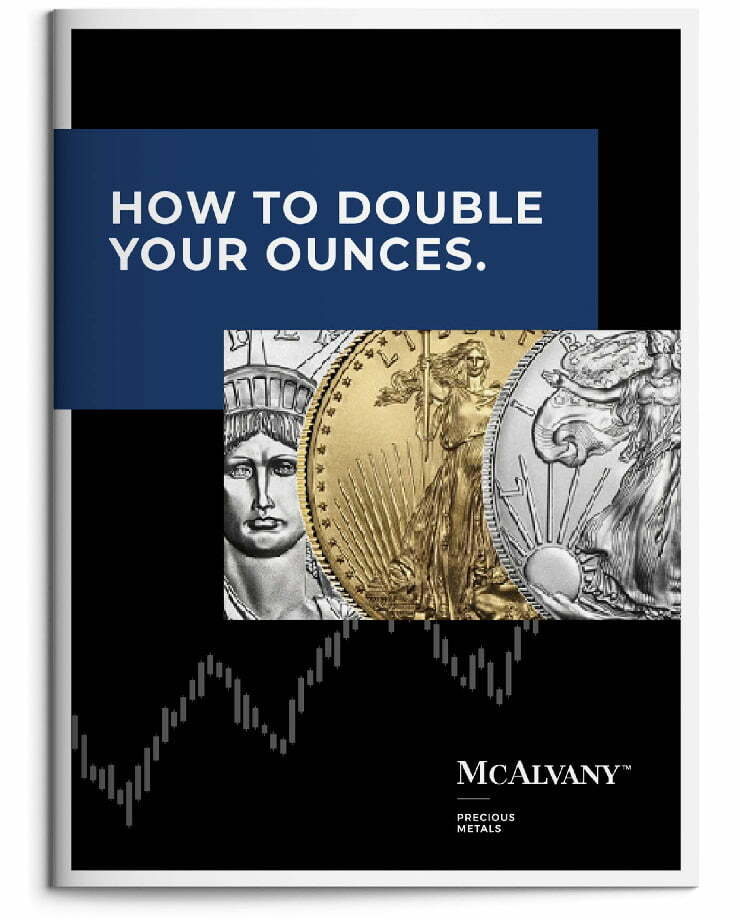Podcast: Play in new window
- Silver Demand In Form Of ETFs Spikes Causing Market Mayhem
- Golden Opportunity To Accumulate 90% Silver Coins
- Silver Lease Rate Soars To 200%
“Just count the stuff that’s coming from the US. 180 tons of silver suggests that this is now more normal pricing. The spot market and futures market come into more standard relationship. How much of a decline off of the $53.56 cent high— Do we see five, ten percent from that? A steeper decline than that? That remains to be seen. What is intriguing is the possibility of spot and futures market volatility being more extreme, even as physical metals—the OTC market—finds its mojo.” —David McAlvany
* * *
Kevin: Welcome to the McAlvany Weekly Commentary. I’m Kevin Orrick, along with David McAlvany.
Well, David, my favorite weekend for the company every year just occurred. We had our McAlvany Wealth Management clients out in rainy Durango, but it was still beautiful. You put a lot of time and effort into meeting with the clients that want to meet with you, so— Often I wish for you to have a nice vacation after this weekend, and that didn’t happen. So I want to talk about what this weekend incorporated after our meeting with the clients.
David: Yeah. Well, a lot to cover today. First, thanks to our asset management clients who were able to come to this year’s conference in Colorado. We’re honored to serve you and pleased you could make the trip to Durango. That face-to-face time is precious to us. And for those MWM clients that could not make it, there will be a full video recording of the weekend’s presentations available shortly. What you missed was the meals, the conversation, the changing leaves, and, as you mentioned, this year, surprisingly, a good bit of rain.
Kevin: Pretty wet.
David: Yeah, it’s a client-only conference, and everybody in the hard asset equity strategy will get it. No need to request it, but if you’d like to become a client, please let us know. I can tell you that the team and the process and the unfolding opportunity are worth the inquiry.
Kevin: Well, and even working with the guys over at MWM, hearing Morgan speak each week, I loved to hear his presentation again. He really put that together well. Philip Wortmann, Robert Draper, you. It’s nice to know that you’ve got people thinking on a daily basis, and a shared worldview is very, very important with investing.
David: Yeah. Thank you to our team at MWM and our advisors at MPM. There’s a lot of effort that goes into these weekends, and I’m grateful for the time and commitment. Many of you traveled from remote work locations out of state, and I have to say, as grateful as I am for technology helping facilitate that arrangement, you’re missed, and it’s always a pleasure to spend time together again.
Kevin: It was nice to have some people that I normally just work remotely with. It would’ve been fine if you would’ve just had a quiet weekend with your clients, but actually, gold and silver weren’t quiet at all. There are some real dynamics going on right now, Dave, that actually would take us back to the 1970s—the last time we had seen some of the chaos. And so talk about that a little bit.
David: Last week, we surpassed 4,000 an ounce, and this week we’re near 4,200 for gold, silver ripped through 50 and only slowed this week at $53.56 cents. At the conference on Friday morning, I was sharing about rapid liquidity issues impacting the silver market, and that continued in severity through the weekend. There are already many internet misconceptions. So as someone that did not have a weekend and was busy engaging with market insiders on many an issue, I’ll share a few insights.
Kevin: I was talking to our bullion manager, and I said, “How was your weekend?” And he said, “Well, I got a call Friday night while you were at dinner, Dave, with our clients.” And he said, “I knew there was nothing I could do really until Sunday, but we had a lot to do.” And so he was here talking with you Saturday. You guys were together Sunday doing things that people who run a 53-year-old precious metals business sometimes have to do.
David: Sure. Silver demand in the form of ETFs was significant last week, well above recent averages. And the annual inflows now exceed $2 billion into silver and about 26 billion for gold just in Q3.
Kevin: So two billion is not that much relative to the gold side, but silver is a thin market, isn’t it?
David: It is. So why do I start with investor appetite for ETFs? Because the destination for those real physical ounces in the form of thousand-ounce bars in the case of silver is London.
Kevin: Okay. So if I’ve got this right, one of the big problems that we had this last week, basically, is a lot of that silver had been moved over to New York, but it actually needed with the ETFs to be delivered in London in a timely manner.
David: Right. Plenty of product, just not in the right place.
Kevin: Okay.
David: So pre-tariff traders were concerned enough about the implications from tariffs to move a significant quantity of metals to New York. Now, with a surge in ETF demand, we find, not absolute shortages of silver, but shortages in the right location. So, as markets do, the solution is being solved by market participants who can arbitrage London premiums and get paid for moving New York ounces back across the pond.
Kevin: So let’s break this down a little bit because last week I had talked about being on the trading floor in New York back in the 1990s. Now that’s a futures market, that’s when you’re buying contracts. I had mentioned Augie at aught. That basically was an August delivery contract at zero zero for gold. But the spot market has always existed in London. Explain the difference between those two markets.
David: Yeah, what’s made the weekend so interesting is the difference in systems between the futures market here in the US and the spot market in London. There are two different trading systems. One that is in real or near real time. That’s the spot market and one that is for future prices and future delivery dates. Again, which can be facilitated with those contracts.
Kevin: And London is spot?
David: London is spot and New York is the futures market.
Kevin: Right.
David: The spot market came under pressure first. A return to a casual comment a moment ago, we had inflows, have had inflows, into silver of about $2 billion, and that’s helped propel the price over 70% year-to-date versus gold inflows via the ETFs of $26 billion in the third quarter,
Kevin: Just the third quarter. What is it for the year so far?
David: 64 billion year-to-date, according to the World Gold Council. Radically different sized markets.
Kevin: Two billion to 64 billion? Yeah. I would say so.
David: Yep. So following the first half of 2024, with net outflows—and again, just go back in time to 2024—first half outflows of seven billion. In the second half you had inflows of 10 billion. So here, we have an additional, 2025, 64 billion. Investors are discovering the allocation necessary to wealth preservation. Silver remains a very small market, relatively speaking. That fact alone will continue to surprise market participants as they try to position in silver ounces. It’s a small market.
So back to the story.
Kevin: Okay. So what occurred this weekend, the best that I can understand, had something to do with the silver being in the wrong place and it needing to be somewhere else. And there’s a cost to that, isn’t there? There’s a cost to borrowing or paying for something that’s in the wrong place.
David: Yeah, ETF demand bumped higher last week, forcing the shift in geography from New York to London. Plenty of silver, but in the wrong place. That’s the gist of it. And the implications have been that silver in the spot market has temporarily dislocated, with lease rates exceeding 200%.
Kevin: Okay, so let’s talk about lease rates before we go on because a lease rate, I didn’t know what a lease rate was until the mid-’90s Dave, and I was visiting a metals firm, Mocatta Metals in New York, and I walked into the room. Mocatta is a 500-year-old precious metals firm. It goes way, way back. But I talked to a man named Steve Abriano who had run the operation for years, and I thought I was going to see something different, but all I saw was the old green screen monitors, and they were the blinking cursor and I was standing next to one and it said, “Nothing for now. Thanks.” On the screen.
And I asked him, I said, what is this? And he goes, “Well, that’s the Russian central bank. They don’t need to borrow any gold.” And he told me that they make a lot of their money at Mocatta loaning gold that’s in one place to another place for a fee. There’s an interest rate fee. So when you’re talking about lease rates, a lease rate is that cost.
David: That’s right. So to borrow ounces as silver is bought and then settle to a new customer, or if you’re a refinery and you take a lease to finance your inventory and then produce product for the end customer, that could be one ounce coins, 10 ounce bars, what have you.
Kevin: And it’s normally at like one and a half, two percent, isn’t it? A lease rate, maybe three?
David: Even less. Even less, but this whole event, again, the lease rate has skyrocketed. 200% is something you see once in a hundred years.
Kevin: Two hundred percent. You told me yesterday 200%, and I walked away thinking it was 200 basis points. No, 200%.
David: Yeah. So the drama is in hedging inventory. Hedging spot silver has increased over 30 cents per day per ounce hedged.
Kevin: Wow.
David: Again, it’s basically your silver price. 200% of that divided by 365, you come up with your daily rate.
Kevin: So give us an example of what that would cost, let’s say on 50,000 ounces.
David: So sitting on inventory hedged, as so many in the market do because you don’t want to take risk. 50,000 ounce position times 30 cents would be $15,000 a day in new hedge costs. So $30,000 for hedging the weekend. Prices had started the week in contango, where the spot price is cheaper than the futures price, and if you can just imagine a forward curve, we’re familiar with the interest rate curve, right?
Kevin: Right.
David: Typically it rises the farther out in time you go.
Kevin: So spot would be what you would consider the short end of the curve, and the futures market would be the longer end of the curve.
David: Yep. So contango is when you’ve got a gradually steepening curve. Backwardation is when you have the opposite, a curve that falls off, where in essence the spot price is higher than the forward month contract.
Kevin: Right. So it becomes costly to hold inventory if you’re in backwardation.
David: Yeah, as the week progressed, last week we shifted from contango towards backwardation—backwardation, and when the spot price exceeds the front month which has the effect of introducing a financing cost for that inventory. So from being paid on inventory to paying for that inventory, in our example $15,000 a day, and you can see margin calls and a demand for liquidity. That’s not unique, but falling over a weekend when that risk cannot be mitigated, and frankly over a three-day weekend, including a bank holiday here in the United States, means that settling the margin calls isn’t possible till Tuesday, something— A liquidity snowball.
Kevin: Isn’t that interesting how timing can sometimes catch you? Columbus Day of all things, right? It’s like, wait, we have margin calls. I’m not talking about us, but I’m talking about these large entities that are highly inventoried or leveraged on this stuff. They can’t meet the margin call because they can’t raise the liquidity.
David: Right.
Kevin: Yeah.
David: It gets more interesting because it’s not just the lease rate. If you want to unwind the hedge, now you’re talking about a difference in bid and ask which could be $1.30, $1.50, $2. So combined, if you multiply times the ounces you have hedged to unwind the hedge and to cover that lease rate, you’re talking about $2.10 to, at its worst, maybe $2.90 per ounce. Well, those round up to three bucks.
Kevin: Right. Wow. That can be spready.
David: That can be painful. So this is temporary. This is temporary. J.P. Morgan immediately sent 20 tons of silver from New York to London, HSBC another 20 tons, and other groups an aggregate of 40 tons from the US, and there’s the potential for more than that actually, something on the order of 150 to 200 tons, all told, between Hong Kong, Singapore, going to London and from New York.
Kevin: Okay. But to repeat, basically a lot of that silver was here based on the fear of Trump tariffs earlier in the year, right?
David: That’s right. Yeah, so given the normal delays of offloading pallets from a 747 and checking the product into London inventory, the product which was sent Saturday will be all settled and in place by Wednesday. So 80 tons will hit the London market. Additionally, a hundred tons is lined up to be delivered by next Thursday here from the US, and then I mentioned what’s coming from Asia as well. But if you just look at the US sourced product heading overseas, $298 million worth of silver, it’s on its way. So the issue is largely resolved except for the increase in hedging costs which will take time to normalize.
Kevin: Isn’t it interesting, though, how different this market is? A physical market is so different. We saw this in the oil market a few years ago where having oil in inventory actually became costly. Remember that? But this is a real thing. This is not a secret number like a cryptocurrency. This is a real thing that needs to be in a real geography somewhere else.
David: Maybe we can come back around to this in our conversation, but the irony is that the danger factor was in the de-risking of the position.
Kevin: The hedging.
David: You want to hedge, and yet the hedge cost moves to a level that it’s no longer sustainable and it forces an unwind. It forces a liquidity event. So this is, I think, something to contemplate when we think about the equity markets, and if you’re concerned about stocks being at a high level, maybe you’re one of the few who’s begun to hedge a position, but the cost of hedging can increase with time and can ultimately become unsustainable. We had that in 1987 where it was hedging strategies, dynamic hedging strategies, which compounded the losses to close to 25% or worse.
Kevin: It was the insurance against risk that actually brought things down.
David: That’s right. So the net effect is, if you’re looking at the physical gold and silver market, that the ask price for silver is high and the bid is low. The bid is the price you’re offered when you’re liquidating.
Kevin: That’s that spread you were talking about.
David: Yeah. So if hedging inventory, a buyer in the wholesale market would then have to discount that product to account for carrying the inventory over a period. So at 30 cents a day, anticipating a 10-day holding period for the inventory, you would put the bid $3 lower, $3 difference between bid and ask, and that’s just to make sure you don’t lose money. That’s not you being opportunistic or price gouging. Somebody wants to liquidate silver and they see the spot price at 50 and the offer or the bid is at 47. Well, this is it, and I can’t tell you what the expected inventory hold is. Maybe 10 days is too short. Maybe it’s just a day, but demand is strong. If it is, then it drives the ask price. Hedging is still an issue that has to be addressed. Hedging costs remain high, which means cautious inventory management. Really, you can’t afford to pay more in the market if you’re playing the market-making function, then it will cost you to buy and hold the inventory.
Kevin: And this just really strikes me as a reason to make sure that if you’re an investor listening to this, it’s good to actually have physical product. Okay? Actually own the physical product because there is counterparty risk even in the physical commodities markets. You’ve got to have liquidity available through the banking system, like this Columbus Day issue, and you also have to have things in the right place at the right time.
David: That’s right. Where this gets interesting is with any global player that held inventory hedged in the spot market, you got margin calls over the weekend, particularly in the US where a bank holiday prevented the settlement of those margin calls, to not cover ounces at the market open on Sunday would’ve been a mistake. To cover those ounces at the market open cost at least $1.30 per ounce to $2 per ounce. So we’ve been in this a long time. You don’t let your losses run.
Kevin: Right. Well, it reminds me of a Shakespeare play where a pound of flesh was the cost. Remember that?
David: Okay, so we lost a finger, we didn’t lose a limb.
Kevin: Right.
David: But your first loss is the best loss. We took a modest haircut on closing out a short position, and have no worries going forward. So smart players I’m sure did the same. Not everyone has those kinds of risk controls in place. So with the price hitting $53.56 cents on Monday night, there are some players who likely lost the three days at 30 cents plus the difference between bid and ask, call it a buck fifty to two bucks, 2.40 to 2.90 an ounce. There’s a lot of folks that will hedge a million ounces.
Kevin: Well, and I’m thinking about leverage. What about the guys who are leveraging this stuff— Okay. It’s even beyond what they actually physically own.
David: So you hedge to avoid losses on your inventory. In this case, the hedge was the risk, and I think that’s worth thinking about because if the markets are assuming that you have liquid and normal functioning as the prevailing conditions in a really pressured period of time, and that’s not the case, liquidity dries up and there is nothing normal. So we had a very abnormal weekend. The same thing I think could ultimately apply to the equity market.
Kevin: This is why you got no risk after the client conference.
David: Yeah.
Kevin: You went from meeting everybody to actually handling a crisis in the metals market.
David: Yeah, so that hypothetical 50,000 ounce position that we were talking about could have cost you as much as 145 grand. That’s basically between 5 and 6% of the value of the position, and going forward, the risk of backwardation and steep carrying costs is what lingers in the market. Odds are that we stay in backwardation through the end of this contract role, which would be the December contract. You may very well have prices that rise, but don’t expect to liquidate with a strong bid because as long as that cost to carry is high, it is what it is.
Kevin: Well, back in the late ’70s— Everyone has heard—or virtually everyone has heard—about the Hunt brothers, but your dad knew Bunker Hunt, I think, quite well. Some of the dynamics of the market at that time—that 1979 run-up in silver and then the subsequent crash based on rule changes—let’s talk about that because that’s, in a way— Some of these mechanisms that we’re talking about now were in play at that time.
David: I know one of the traders who worked for the Hunt brothers and, as a part of the settlement with the government, he was banned from trading commodities for the rest of his life.
Kevin: Wow.
David: They went after the Hunts without any mercy, and believe it or not, the Hunts didn’t purchase an ounce of silver over $15 an ounce.
Kevin: That’s what I heard.
David: So a lot of the frenzy in price was the investor coming to the market and playing the momentum trade. But I think there is a similar dynamic this weekend to what played out in 1979, 1980. You had short positions, they pressed industry players—groups like Mocatta, which you mentioned earlier—pushed them to the wall, and COMEX intervened to the benefit of its members, including Mocatta, who were hemorrhaging hundreds of millions of dollars a day. Of course, it destroyed the Hunt brothers’ silver position in the process.
And one of the ways that COMEX did that is they changed the rules in the futures market. Again, this has nothing to do with the over-the-counter market, the physical gold market, but COMEX changed the rules in the futures market to sell only. Those were the only trades—
Kevin: You couldn’t buy. You couldn’t buy. You could only sell.
David: That’s right. Only sell orders, and the price retreated, saved Mocatta, saved others.
That sounds shady? Well, it is. It’s not always what you know, but who you know. And the Mocatta brothers, one in London, one in New York, they knew who to call.
Kevin: When you’re too big to fail, that doesn’t mean that everybody’s too big to fail, right? I mean, you can tap them.
Do you think that they’ll do that again?
David: I don’t anticipate COMEX doing that today. Of course, they can change margin requirements—the amount of money that you have to have as skin in the game on a futures contract. You don’t have to have it fully funded. And that is where you can find forced liquidations, where somebody has to come up with more money to keep the trade in.
That they do as a way of making sure that there’s adequate skin in the game. It is a normal process in a rising market, whether it’s corn, soybeans, wheat, gold, silver, what have you.
Kevin: Right. And increasing the margin requirement, just to explain, is if you can put 10% down to control a hundred percent of something, at some point they may say, “No, we want the 100%.” Or there are occasions, I remember in the palladium market, they actually raised it to 200% when there was some problem.
David: Amazing. Ordinarily, it moves in smaller increments from 10 to 15, from 15 to 25, from 25 to 50. That 100% margin requirement would be their way of saying, “We’re not really interested in you placing the trade.” In fact, they’re encouraging you to sell versus buy because you’ve got to come up with a lot more money.
Kevin: Show me the money.
David: Yeah. So the physical market is very different than either of the two we’ve been talking about—spot or futures—and supply and demand, clean and neat as it is in the over-the-counter market, products are priced as a reflection of supply and demand. So price, I think, more accurately reflects reality in the OTC market, in the physical metals market.
In the futures market, you don’t have to have the product, and you can make a leveraged bet in either direction. And I recall the fall of 2008, in the early stages of the Global Financial Crisis, gold prices dropped between 20 and 30%.
And that’s usually at the front end of a major liquidity crisis. You see people scrambling to raise liquidity so they can keep their bets in play. And then at a later stage of a deleveraging, they realize that they probably want the security of the metal more than the bets that they were trying to maintain. And so a dip in price, pretty normal at the front edge of a deleveraging.
Kevin: Because it’s so liquid. But this absolutely exemplifies what you’re talking about—the difference between the cost of something now versus the cost of something later.
David: Yeah, because in the futures market, the gold prices dropped 20 to 30%.
Kevin: Back in 2008.
David: Yet to acquire metals for immediate delivery, the price was the same.
Kevin: Never dropped.
David: You were sitting at 900 to $1000 if you wanted immediate delivery.
And only if you were willing to accept March delivery—that’s four months later—could you get the discounted price tied to the futures contracts and the future delivery of material in the supply chain pipeline.
Kevin: Yeah. So I’ll gladly pay you Tuesday for a hamburger today. I mean, that concept is in play here, isn’t it?
David: Well, people were willing to pay the premium—the over-the-counter premium—for immediate delivery because real-time counterparty concerns, in the context of 2008 and 2009, overwhelmed that drive towards bargain hunting. If you think, “Well, I’d rather save myself an extra 20, 30%, I’ll just take delivery in March.”
That really wasn’t the spirit. What if the future was worse than the present, and the product was not available as expected? Or, even worse, COMEX played another of their tricks? They settled in cash, instead of in kind? Because those contracts don’t have to deliver metal, they have the opt-out mechanism of settling in cash, closing out paper contracts with paper scrip.
Kevin: Do you think the pain that was suffered by some of these larger wholesalers this weekend, do you think that is possibly going to readjust their mindset going forward as to their way they’re holding gold and where?
David: I think it might, and I suspect it’ll have a recalibrating effect on the investor mindset as well. And physical metals in the over-the-counter market should become more interesting, and, I think, with them an increase in premiums.
We’ve had an extended period of time where central banks have driven prices higher, and so official buying, as they like to call it, and investor appetite for metals, expressed particularly in areas like the ETFs, in the form of ETFs, they’ve driven demand for large format products. So that’s large gold bars for GLD, that’s 1000-ounce silver bars for silver.
Kevin: It’s the stuff people don’t hold in their hand. Large format.
David: Yeah, you wouldn’t want to, but ETF demand is a critical force multiplier for the metals market, and it continues to be the easiest avenue to satiate investor demand.
Refiners can crank out large format product with incredible efficiency. But as the demand for metals increases via ETFs, and refineries meet that demand with freshly minted bars, the refineries will necessarily cut back production on small format products like one ounce, 10 ounce, 100-ounce silver and gold.
There’s another factor here, too, which is they are subject to the lease rates, and it may be that they don’t produce anything.
Kevin: So if they’ve got 1000-ounce bars in the back room and they know they’re going to make coins out of them, okay, what you’re basically saying is if they’re having to pay a lease rate on that, the lease rates, there’s a cost to not getting that turned into a coin right away, right?
David: Right. I mean, there is a scenario where, because of high lease rates, which they’ve come down from 200% to 51% today.
Kevin: 51%.
David: Yeah, 51%.
Kevin: [Unclear] keep coming down.
David: Again, just roughly translate this. If I’m holding a silver inventory for 365 days, it will cost me $25 out of the $50—
Kevin: Half the price of the silver.
David: —just to borrow it. Or in this case as we view it, insure it.
So yeah, this scenario is interesting because if lease rates stay high, refineries do not have enough margin in the product that they produce—either 1000-ounce bars for the ETFs, large format bars for GLD, or the small products that consumers are more interested in—
And again, it’s just because of the mechanisms. It’s because of the process involved. They lease the gold, they’re paying for it, and that costs them something, but that’s okay because they produce it and sell it at a certain margin.
Well, if the lease rates are too high, it squeezes their margins, and it is better for them to do nothing. It is better for them to-
Kevin: Sit on their hands.
David: —not produce product. So you will see how long these rates stay high. Maybe it’s a week. My guess is that they are somewhat stubborn through the December contract.
Kevin: Could this be an environment, then, where we start to see premiums rise on material that already exists in small format?
David: Yeah. So these are the kinds of environments that stimulate premium trades. Maybe that’s American Eagles, maybe that’s junk bags. Anything small format could see, over the next six to 12 months, a healthy increase in the wholesale market premium. If there is not new product being minted, being manufactured by the refineries, now you’re working through the old inventory. It’s secondary market product.
Kevin: Well, and it reminds me of what occurred just a couple of years ago with the Silver American Eagles. I mean, it didn’t rely on lease rates, but if you recall, there were not enough silver American Eagles to meet the demand.
And so the premium jumped way up. We moved out with our clients into 100-ounce and 1000-ounce bars. We waited, and then when there was enough product, we moved back in. And compounding ounces is a beautiful thing, Dave.
David: If I recall correctly, in that last period where the premiums on Silver Eagles were 50 to 70% over the spot price, that was when the mint shut down production. They basically said, “We’ve produced what we were going to, we met our quota for the year.”
Kevin: Time for vacation.
David: But there was still demand in the market, and that demand in the market had already eaten up all the primary production.
Then it went to the secondary market for all the backdated products. As soon as that product was gone, then we also saw premiums on junk bags increase. I think we got 30% out of that particular trade.
And so, yeah, compounding ounces, that’s been a key differentiator for our company, and it’s this kind of setup that allows for compounding.
So the key factor, which has to normalize, is hedging costs. Those have to come down. And if that happens, then bids will rise. Otherwise, the bid-ask spread can continue to remain blown out. And premium trades, you can’t capture them.
You have to have the ask price move, but the bid has to follow. And that is going to be a function of the— just call it the cost of capital.
Kevin: Yeah, well, cost of insuring the capital, right?
David: Yep. As I mentioned earlier, the market resolves these price issues quickly via arbitrage. Most people, however, are not prepared to lease 747s and fill them with 1000-ounce bars for delivery to London.
Kevin: That sounds like a James Bond movie, doesn’t it? I mean, filling 747s full of silver, getting them back over to London so that you can settle a trade.
David: Yeah. But some people are. Some people are prepared to do that. Some people already have captured the price differential between London and New York. And arbs—or arbitrage opportunities—last but a second, and only the experienced industry trader is able to take advantage of that.
Kevin: Right.
David: And go back to COVID. And remember the Cushing WTI where oil was trading negative.
Kevin: What was it, negative 30 bucks or something a barrel? It was crazy.
David: I forget the exact figure.
Kevin: If you had inventory in oil, it cost you. You didn’t own anything, right?
David: Right, it cost you to hold the inventory.
Kevin: That’s crazy.
David: So not everyone has the resources to float a tanker with oil and wait for prices to normalize. But if you do, and did, and prices normalized—
Kevin: Well, okay, yeah, the price is normalized. But do you remember how volatile the price of oil was during that period of time? Should we expect that with silver? I mean, is silver going to maintain over 50 right here, or are we going to see some real volatility because of this?
David: That’s anyone’s guess. I mean, it remains to be seen if silver can maintain prices over $50. It could correct, but every day it remains over 50, the likelihood of $60 and $70 silver by year-end increases. An 80 to one ratio still argues for leaning into a silver position. Thus far gold has been the better investment over the last four or five years, and you really need to see that ratio begin to move into the 70s and 60s and 50s for that trade to have paid. Thus far, guess what made the difference in a metals portfolio? Diversification. If you’re a hundred percent silver, you’ve been mostly wrong until this year’s move. So three, four years of having some explaining to do.
Kevin: Right.
David: And really, that kind of singular bet implies that you know more, you think you know more than you actually do. So we do like to diversify a portfolio across gold, silver, platinum, palladium. And when I described leaning into a silver position, it would be increasing the percentage allocation compared to the norm.
Kevin: Right, but not giving up your gold. Having some gold in the portfolio as well. Yeah.
David: That’s right. That’s right. But if the ratio’s momentum shifts and crosses over to the 70 to one, the 60 to one, that’s when silver will have been worth owning. More to the point, if refineries are now on alert, what are we going to produce? Is it going to be large format bars to meet ETF demand? Will they even be able to do that, given the high lease rates? I think certainly more investment dollars will flow to that small format product. It’s immediately available. There’s no fuzz on it. There’s no delay in delivery, and actually there is plenty of product available. So if somebody’s saying, “Oh, there’s a silver squeeze on.” Yeah, not really.
Kevin: There’s plenty of silver so far. It’s just in the wrong place, in the wrong format.
David: This is a London squeeze, it’s not a silver squeeze. And it happens to include silver, but I think that distinction is important. So, yeah, this weekend was a wake-up call for ETF providers, wake-up call for refineries. They’re going to need to address supply lines and make sure that they are positioned as best they can. The complicating factor, of course, is tariffs. We don’t know exactly what tariffs will be applied, if any, money and metals moving one direction or the other.
Kevin: Yeah. So silver being an industrial metal is a little different. Yeah, Trump already said he doesn’t want tariff gold, but silver is an industrial metal. You could see copper or anything coming from certain countries tariffed, right?
David: Yep. And you have your own arbitrage opportunity as an investor in the small product market. Gold and silver, lowest premiums in decades, but I don’t think those premiums are likely to stay there long.
Kevin: Okay. So to prepare the investor right now, as this thing starts to settle, as these 747s start to land and get unloaded, we could see a decline in silver. Maybe a normalization of the price, or not?
David: Well, the arbitrage opportunity will be resolved. It was taken advantage of, past tense, already, with the 80 tons already landed and being checked in Wednesday of this week. A hundred tons more coming. And again, I don’t have an exact figure, but it could be upwards of 180 to 200 tons coming from Singapore and Hong Kong as well.
So just count the stuff that’s coming from the US, 180 tons of silver suggests that this is now more normal pricing. The spot market and futures market come into more standard relationship. How much of a decline off of the $53.56 high? Do we see five, 10% from that? A steeper decline than that? I mean, that remains to be seen.
What is intriguing is the possibility of spot and futures market volatility being more extreme, even as physical metals, the OTC market, finds its mojo just as it did in the fourth quarter of 2008. Because again, whatever weakness there was in the paper gold market—and this is back to how you’re positioning in contracts—it ends up being very different. So future prices may go lower, but product for immediate delivery may not.
Kevin: Right.
David: It may not. Both metals, if we’re looking at over $4,000 an ounce for gold and currently over $50 an ounce for silver, both metals are expensive.
Kevin: I love what you say, though. They’re expensive, but they’re not overbought. Where are the army ants?
David: I would say they are expensive and they are overbought, but very importantly, they’re under-owned.
Kevin: Under-owned. That’s right. Yeah.
David: They’re under-owned.
Kevin: Yeah.
David: And I’d say they’re under-owned by eight billion people.
Kevin: Yeah, that’s true.
David: Again, I’ll say that again—
Kevin: That’s the army ant part.
David: —under owned by eight billion people.
Kevin: Yeah, that’s right.
David: And this in the meeting that on a weekly basis you can see inflows into equity ETFs, five, 10 billion into US equities. Those are not remarkable weeks. We’re talking about a 70% move in silver on two billion for the year.
Kevin: For the year.
David: Right?
Kevin: There’s your thin market, right there.
David: The amount of capital that has entered these markets and the amount of capital that is busy as can be still buying investment grade debt and high yield debt and US equities and everything tech, because of course AI is the revolution—
Kevin: Oh, yeah.
David: I think it’s very interesting.
Kevin: Well, okay, so just in summary on what’s gone on this weekend, it’s good to own some small format product, whether in hand or in an IRA or what have you. We can do that. But also the Vaulted program, Dave, for a person who just wants to be able to move into silver for a while, maybe move back into their checking account without moving anything. Vaulted, has that been affected by the weekend?
David: No, it hasn’t.
Kevin: Okay.
David: See, and of course we’ll monitor that on a daily basis. But the ETFs alongside platforms like Vaulted, our Vaulted program, I think they’re transformative. They’re transformative products that make allocations easy and immediate and seamless for asset managers. I would suggest that we forget the market noise of last week and this week and keep the market signal clearly in mind. This is a well-supported bull market, and it’s breaking out to new highs. You’ve got current dynamics, which may have given you a gift, lower premiums and ultimately scarce wealth insurance.
Kevin: Okay, so expensive, overbought, but under-owned.
David: Not over-owned.
Kevin: Yeah. Wow. The army ants are coming.
* * *
Well, you’ve been listening to the McAlvany Weekly Commentary. I’m Kevin Orrick, along with David McAlvany. You can find us at mcalvany.com and you can call us at (800) 525-9556.
This has been the McAlvany Weekly Commentary. The views expressed should not be considered to be a solicitation or a recommendation for your investment portfolio. You should consult a professional financial advisor to assess your suitability for risk and investment. Join us again next week for a new edition of the McAlvany Weekly Commentary.
















